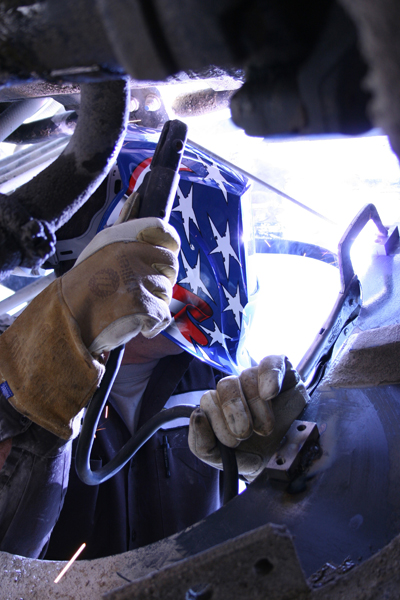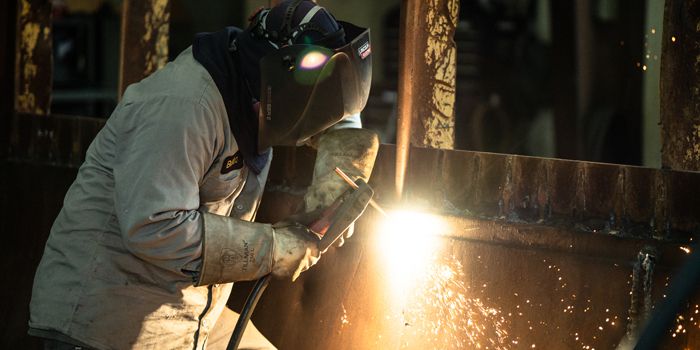Typical Welding Repair Service Issues and Just How to Address Them Successfully
Welding repair work typically encounter a series of issues that can endanger the integrity of the end product. Common issues consist of insufficient penetration, porosity, and imbalance, among others. Each issue provides distinct difficulties that call for specific approaches for resolution. Recognizing these concerns is vital for welders aiming to improve their skills and end results. This conversation will check out these typical welding repair concerns and effective approaches to resolve them.
Poor Penetration
Insufficient penetration occurs when the weld steel falls short to completely fuse with the base product, resulting in weak joints and prospective architectural failures. This issue frequently originates from not enough warm input, wrong electrode angle, or improper welding rate. Welders might run into poor penetration because of a miscalculation of the essential parameters for a certain material density or kind. Furthermore, contamination on the base product's surface can prevent efficient bonding, exacerbating the problem. To resolve inadequate penetration, welders must ensure proper setups on their tools and keep a tidy work surface area. Normal assessment of welds is advised to recognize any shortages early, permitting prompt corrections and the prevention of jeopardized architectural stability in bonded settings up.
Porosity
Porosity is a typical problem in welded joints that shows up as tiny gas bubbles caught within the weld metal. This defect can endanger the integrity of the weld, causing lowered strength and possible failing under stress. Belgrade. Porosity normally occurs from contamination, dampness, or inappropriate welding techniques, which allow gases to run away into the liquified weld swimming pool. To resolve porosity, welders should guarantee proper surface area preparation, keep a tidy working setting, and make use of suitable welding criteria. Additionally, choosing the appropriate filler product and shielding gas can minimize gas entrapment. Routine assessment and testing of welds can aid recognize porosity early, assuring prompt rehabilitative activities are taken, thereby preserving the quality and dependability of the bonded structure
Misalignment
Misalignment in welding can develop from numerous variables, including improper configuration and thermal growth. Recognizing the source is vital for effective resolution. A number of modification techniques are readily available to realign components and guarantee architectural integrity.
Root causes of Misalignment
Welding imbalance often originates from a selection of underlying concerns that can jeopardize structural stability. One primary cause is inappropriate fit-up of components before welding, which can result in spaces and unequal surfaces. Variants in thermal growth throughout the welding procedure can additionally lead to distortion, specifically if the products being signed up with have different coefficients of development. Additionally, poor fixturing and clamping might fail to hold parts securely in position, resulting in activity throughout welding. Improperly maintained devices, including welding machines and tools, might introduce variances in the weld bead, more adding to misalignment. Operator error, stemming from not enough training or experience, can likewise play a significant duty in creating misaligned welds.

Modification Techniques Offered
Dealing with misalignment efficiently needs a combination of restorative methods customized to the certain problems available. One usual method is making use of fixtures or jigs to hold elements in the right placement during welding, making sure consistent positioning. In addition, pre-heating the materials can help in reducing distortion and enhance fit-up. For significant misalignment, mechanical realignment methods, such as using hydraulic jacks or clamps, can be used to deal with the setting before welding. Post-weld warm therapy may additionally be necessary to eliminate stress and anxieties triggered by misalignment. Mindful assessment and change throughout the configuration stage can stop imbalance problems from coming to be substantial issues, advertising a smoother welding process and boosting general architectural stability.
Distortion
Distortion is a common challenge in welding that can develop from different aspects, including irregular heating & cooling. Understanding the causes of distortion is crucial for implementing effective prevention strategies. Resolving this concern not just improves architectural stability however also boosts the overall top quality of the weld.
Reasons of Distortion
When based on the extreme warmth of welding, products typically undergo adjustments that can cause distortion. This phenomenon primarily arises from thermal development and tightening during the welding procedure. As the weld area warms up, the product increases; upon air conditioning, it contracts, which can develop inner stress and anxieties. Additionally, irregular home heating across a work surface can intensify these tensions, resulting in warping or flexing. The sort of material likewise plays a substantial role; steels with differing thermal conductivity and coefficients of expansion may respond in different ways, leading to unpredictable distortions. Poor joint style and poor fixturing can contribute to imbalance during welding, boosting the possibility of distortion. Comprehending these reasons is crucial for reliable welding repair work and prevention methods.
Prevention Techniques
Effective prevention strategies for distortion during welding focus on regulating heat input and guaranteeing appropriate joint design. Maintaining a constant warm input aids to lessen thermal growth and contraction, which can bring about distortion. Making use of strategies such as pre-heating the workpiece can additionally reduce the temperature gradient, advertising consistent home heating. In addition, selecting proper joint layouts, such as T-joints or lap joints, can improve security and minimize stress and anxiety concentrations. Executing correct fixturing to safeguard the work surfaces in position better help in preserving alignment during the welding process. Staggered welding series can distribute heat more equally, avoiding localized distortion. By applying these strategies, welders can substantially lower the likelihood of distortion and enhance the general top quality of their welds.
Breaking
Cracking is a common issue run into in welding repair work, frequently resulting from numerous variables web such as inappropriate air conditioning prices, product option, or inadequate joint prep work. The event of cracks can greatly jeopardize the honesty of the weld, leading to potential failings throughout operation. To address this concern, welders must first analyze the origin, ensuring that materials are suitable and properly selected for the details application. Furthermore, controlling the air conditioning price throughout the welding procedure is important; rapid cooling can induce stress and anxiety and lead to splitting. Proper joint design and preparation additionally add to decreasing the threat. Applying these strategies can boost weld quality and sturdiness, inevitably lowering the possibility of splitting in finished weldments.

Incomplete Fusion
A considerable issue in welding repairs is insufficient fusion, which occurs when the weld steel does not effectively bond with the base material or previous weld passes - Montana Mobile Welding and Repair. This problem can result in weak points in the joint, possibly compromising the integrity of the bonded structure. Variables adding to insufficient fusion consist of inadequate heat input, inappropriate welding strategy, and contamination of the surface areas being joined. To resolve this here are the findings problem effectively, welders need to guarantee appropriate pre-weld cleaning and surface prep work, in addition to adjust their welding specifications to attain sufficient infiltration and fusion. Regular assessment during the welding process can additionally aid identify insufficient fusion early, enabling for prompt rehabilitative procedures to boost the general high quality of the weld
Overheating
While welding fixings can enhance architectural honesty, overheating offers a significant obstacle that can lead to material deterioration. Extreme heat throughout welding can alter the mechanical residential or commercial properties of metals, leading to reduced toughness, increased brittleness, and bending. This phenomenon is specifically crucial in high-stress applications where structural reliability is critical. Determining getting too hot can entail aesthetic evaluations for discoloration or distortion, along with checking temperature level during the welding process. To reduce the risks related to getting too hot, welders must use appropriate methods, such as regulating warm input, readjusting traveling rate, and using appropriate filler materials. Additionally, applying pre- and post-weld warm therapies can help restore material residential or commercial properties and enhance the overall top quality of the repair, ensuring long-lasting performance and safety.
Often Asked Inquiries
What Are the Common Indications of a Welding Issue?

Just How Can I Examine My Welds for Quality?
To test welds for high quality, one can make use of aesthetic assessments, ultrasonic testing, and radiographic methods. Each technique assures structural honesty, determines issues, and validates adherence to specified requirements, eventually improving the dependability of the welded joints.
What Safety Preventative Measures Should I Take While Welding?
When welding, one must focus on safety by wearing suitable individual safety tools, guaranteeing correct ventilation, safeguarding combustible products away, maintaining a tidy work space, and knowing surroundings to stop crashes and injuries.
Can I Fix a Weld Without Redesigning the Entire Joint?
Repairing a weld without redesigning the whole joint is feasible, depending upon the damage (Belgrade). Techniques such as grinding, adding filler material, or making use of a welding process can effectively deal with specific imperfections while protecting the surrounding framework
What Devices Are Necessary for Reliable Welding Fixes?
Essential tools for effective welding repairs consist of a welding equipment, cord brush, grinder, protective gear, clamps, and filler products. Each device plays a vital function in making sure quality and safety and security during the repair work process. Porosity usually occurs from contamination, dampness, or inappropriate welding methods, which permit gases to escape right into the liquified weld swimming pool. Inadequately conserved tools, including welding makers and devices, might introduce incongruities in the weld bead, more contributing to misalignment. When subjected to the extreme heat of welding, products often go through changes that can lead to distortion. Cracking is an usual concern run into in welding repairs, usually resulting from numerous factors such as improper air conditioning rates, product option, or insufficient joint prep work. A considerable problem in welding fixings is incomplete fusion, which happens when the weld steel does not sufficiently bond with the base product or previous weld passes.